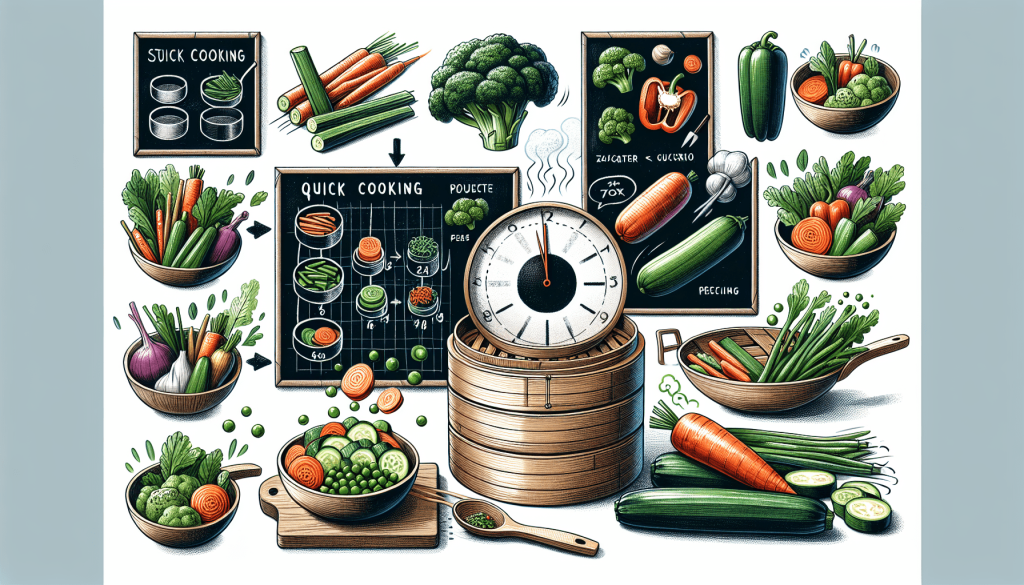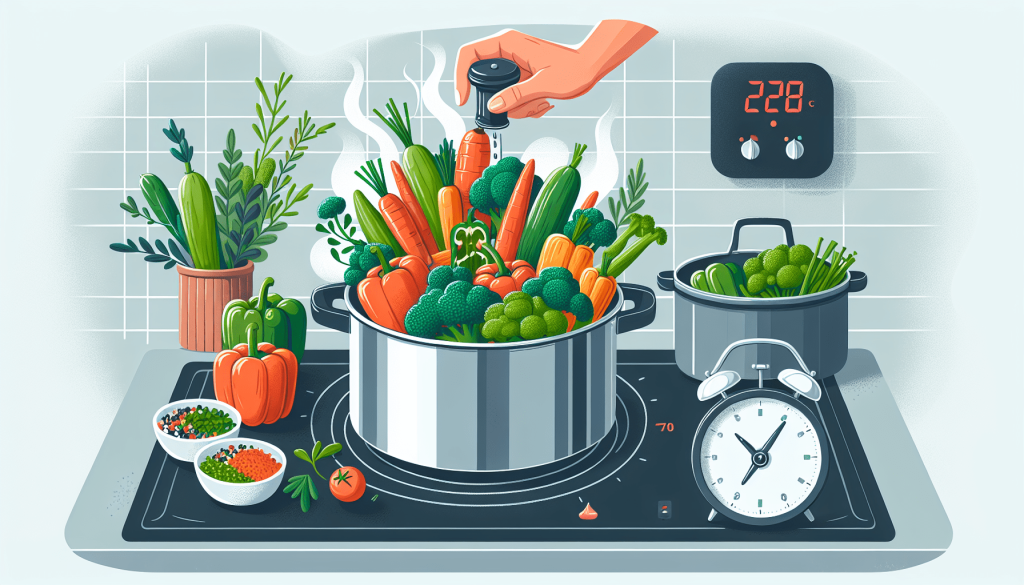If you’re tired of your vegetables turning out soggy and overcooked, then you’ve come to the right place. In this article, we will share with you the most popular cooking tips for achieving perfectly steamed vegetables every time. Whether you’re a beginner in the kitchen or an experienced chef, these tips are sure to help you take your vegetable game to the next level. Say goodbye to mushy broccoli and bland carrots, and say hello to vibrant, tender veggies bursting with flavour. So, grab your steamer and let’s get cooking!

Choosing the Right Vegetables
When it comes to steaming vegetables, choosing the right ones is crucial for achieving the best results. One important factor to consider is selecting vegetables with similar cooking times. This ensures that all the vegetables will be perfectly cooked and ready to serve at the same time. It would be frustrating to have some vegetables undercooked while others are overcooked.
Another consideration is choosing fresh and vibrant vegetables. Look for vegetables that have bright colors, firm textures, and no signs of wilting or browning. Fresh vegetables not only taste better but also retain more nutrients, making them a healthier option.
Lastly, think about the size and thickness of the vegetables. Cutting vegetables into uniform sizes allows for even cooking. This is especially important when steaming a variety of vegetables together. Smaller vegetables will cook faster, while larger ones will take longer. Adjust your steaming time accordingly to ensure all the vegetables are cooked to perfection.
Preparing the Vegetables
Properly preparing the vegetables before steaming is essential for achieving the desired texture and flavor. Start by washing the vegetables thoroughly to remove any dirt or impurities. This step is particularly crucial if you’re using vegetables straight from your garden or farmers market.
After washing, trim and cut the vegetables into uniform sizes. This not only ensures even cooking but also enhances the visual appeal of the final dish. Whether or not to peel the vegetables depends on personal preference. Some vegetables, like potatoes and carrots, are commonly peeled, while others, like zucchini and bell peppers, can be left unpeeled for added texture and nutrients.
To retain some moisture and prevent the vegetables from drying out, it’s recommended to leave a bit of moisture on the vegetables before steaming. This can be achieved by patting them dry with a clean towel or briefly rinsing them with cool water and shaking off the excess.
Using the Correct Steaming Equipment
Choosing the right steaming equipment is essential for achieving the perfect steamed vegetables. One popular option is using a steamer basket, which fits on top of a saucepan or pot filled with boiling water. The steam rises through the basket, cooking the vegetables evenly. This method allows for larger quantities of vegetables to be steamed at once.
Another option is a bamboo steamer, which adds a delightful aroma to the vegetables. Bamboo steamers are placed over a pot of boiling water and allow the steam to circulate through the stackable layers. They are excellent for steaming delicate vegetables such as bok choy and asparagus.
A microwave-safe dish with a lid can also be used for steaming vegetables. Simply add a little water to the dish, place your vegetables inside, cover it, and microwave on high until tender. This method is quick and convenient, especially when you’re short on time.
For a unique and flavorful twist, consider making foil packets for grilling. Place the vegetables on a large piece of aluminum foil, season them, and fold the foil to create a secure packet. Cook the packet on a heated grill until the vegetables are tender and infused with smoky flavors.
Seasoning the Vegetables
While steaming vegetables preserves their natural flavors, adding some seasoning can elevate the taste and make them even more enjoyable. One simple way to enhance the flavor is to add salt and pepper to the steaming water. This subtle seasoning infuses the vegetables with a touch of seasoning while they cook.
For those who prefer more flavor, using vegetable or chicken broth instead of water can add depth to the vegetables. The broth will permeate the vegetables as they steam, resulting in a rich and savory taste. You can also experiment with different herbs and spices to suit your taste preferences. Sprinkling herbs like thyme, rosemary, or dill, or adding spices like garlic powder or paprika, can bring a burst of flavor to the steamed vegetables.
Once the vegetables are steamed, consider drizzling them with a little olive oil or melted butter before serving. This not only adds a pleasing richness to the vegetables but also helps to bring out their natural flavors. Be mindful of the quantity used, as a little goes a long way.

Timing and Temperature
Timing and temperature are crucial factors when it comes to steaming vegetables. Each vegetable has its own steaming time, which should be followed to ensure optimal doneness. Root vegetables like potatoes and carrots generally take longer to steam, while tender vegetables like broccoli and zucchini require less time. It’s important to check the recommended steaming times for the specific vegetables you are cooking.
To avoid overcooking the vegetables, it’s a good idea to periodically test their tenderness. Carefully poke the vegetables with a fork or skewer to check if they are cooked to your desired consistency. The fork should easily penetrate the vegetables without any resistance.
Maintaining a gentle simmer or low heat throughout the steaming process is key to achieving perfectly steamed vegetables. Too high of heat can lead to uneven cooking and potential burning, while too low of heat can result in undercooked vegetables. Adjust the heat as necessary to maintain a steady and gentle simmer.
Remember that steaming times can be adjusted based on the desired doneness of the vegetables. If you prefer your vegetables to be more tender, simply steam them for a few extra minutes. On the other hand, if you like your vegetables to have a bit of crunch, reduce the steaming time slightly.
Monitoring the Steaming Process
Keeping an eye on the steaming process is essential for achieving the best results. It’s important to check the water level regularly to ensure there is enough steam to cook the vegetables. If the water level gets too low, add more hot water to the pot to prevent the vegetables from drying out or burning.
Avoiding excessive steam escaping from the steamer is crucial for efficient cooking. Steam escaping rapidly can lead to longer cooking times and potentially unevenly cooked vegetables. Ensure that the steamer is tightly covered to prevent too much steam from escaping.
Covering the steamer tightly also helps to retain heat and moisture within the steamer. This creates a steam-filled environment that surrounds the vegetables, resulting in optimal cooking. The trapped steam will circulate and cook the vegetables evenly from all sides.
Preserving Nutrients in Steamed Vegetables
Steaming vegetables is one of the healthiest cooking methods as it helps to preserve the nutrients and vitamins. To maximize the nutrient retention, it’s recommended to use minimal water for steaming. This reduces the contact between the vegetables and water, minimizing nutrient loss.
Steaming vegetables for a shorter duration is another way to ensure nutrient preservation. Overcooking can lead to nutrient degradation, so it’s important to steam the vegetables until they are just tender. This preserves their vibrant colors, textures, and nutritional value.
To ensure even steaming, it’s best to cook vegetables in small batches. Overcrowding the steamer can lead to uneven cooking and potentially overcooking some vegetables while undercooking others. By cooking in small batches, each vegetable can receive proper heat and steam distribution.
Avoid pre-soaking or excessive rinsing of vegetables before steaming. While it’s important to wash vegetables to remove dirt and impurities, excessive rinsing can cause nutrient loss. It’s best to rinse them briefly and shake off any excess moisture before steaming.
Enhancing Texture and Color
Steamed vegetables can be incredibly flavorful and visually appealing when cooked to perfection. To achieve an ideal texture, it’s recommended to retain a slight crunch in the vegetables. Overcooking can result in a mushy texture, so aim for vegetables that are tender yet still have some firmness.
To bring out the vibrant colors of the vegetables, steam them until they become vibrant and tender. Be mindful of the cooking time for each vegetable, as steaming for too long can lead to loss of color and overcooked vegetables. The goal is to have vegetables with bright hues that are visually enticing.
Blanching and shocking techniques can be used to enhance the colors of certain vegetables. After steaming, quickly plunge the vegetables into ice water to halt the cooking process. This helps to preserve the bright colors and provide a more pleasing visual appeal.
To maintain crispness, using ice baths is particularly beneficial. After steaming, place the vegetables in a bowl of ice water for a few minutes to cool them rapidly. This gives the vegetables a refreshing crunch while retaining their natural flavors.
Creative Variations in Steamed Vegetables
Steamed vegetables offer countless possibilities for culinary creativity. One way to add a refreshing twist is by adding citrus zest to the vegetables. Grate the zest of lemons, limes, or oranges and sprinkle it over the steamed vegetables for a burst of citrusy flavor that complements the natural sweetness of the vegetables.
For an extra crunch, sprinkle toasted nuts or seeds on top of the steamed vegetables. Toasted almonds, sesame seeds, or pumpkin seeds can add a delightful texture and nutty flavor. This simple addition takes your steamed vegetables to a whole new level.
If you desire a tangy taste, toss the steamed vegetables with a light vinaigrette or freshly squeezed lemon juice. This adds a zesty and tangy kick to the vegetables, enhancing their overall flavors. The acidity also helps to balance out the natural sweetness of the vegetables.
Combining complementary vegetables or fruits can provide a delightful mix of flavors and textures. Consider pairing steamed broccoli with roasted red peppers or steamed asparagus with cherry tomatoes. These combinations create a harmonious blend of flavors that make your steamed vegetables more exciting and satisfying.
Serving and Presentation
To elevate your steamed vegetables to restaurant-quality, pay attention to the way they are seasoned and presented. Before serving, add some finishing touches to the vegetables. Season them with a sprinkle of salt, a pinch of freshly ground black pepper, or a squeeze of lemon juice. These small additions can make a huge difference in the overall taste.
Garnishing with fresh herbs or edible flowers can make your steamed vegetables visually stunning and add a pop of flavor. Consider using herbs like parsley, cilantro, or basil to garnish your dish. Edible flowers, such as nasturtiums or pansies, can add a touch of elegance and sophistication to your presentation.
Arranging the steamed vegetables attractively on a platter can make them even more appetizing. Use different colors, shapes, and sizes to create a visually appealing display. Consider using a mix of large and small vegetables, arranging them in a visually pleasing pattern, or creating a vibrant rainbow of colors.
To complete the experience, offer suitable dips or sauces to accompany your steamed vegetables. Consider serving a creamy garlic dip, a tangy yogurt sauce, or a spicy peanut sauce. These dips can complement the flavors of the steamed vegetables and provide a delicious contrast.
Remember, perfectly steamed vegetables not only taste great but also provide a healthy and nutritious addition to any meal. With these tips and techniques, you can confidently cook steamed vegetables that are bursting with flavor, retain their vibrant colors, and offer a delightful crunch. So go ahead and explore the wonderful world of steamed vegetables, and enjoy the numerous benefits they provide for your overall well-being.
